How To Build a Successful Amazon FBA Business in 2024? Regardless of what skeptics claim, selling on Amazon is not a dying endeavor. But it’s also true that the dynamics of establishing and growing an Amazon FBA brand have transformed in the last ten years, necessitating a strategic approach.
This comprehensive guide outlines all critical facets of building an Amazon FBA brand in 2024, including the costs, brand development, brand registry, and more. Ready to learn everything you need to know about Amazon brand building? Read on.
What You’ll Learn:
- What is an Amazon FBA brand
- How much does it cost to get an Amazon brand?
- How much does it cost to get a brand approved on Amazon?
- Do I need to create a brand on Amazon?
- How Amazon brand registry can help establish your brand
- Create a compelling Amazon listing to solidify your brand
- How exactly can I brand my product on Amazon?
- Conclusion
What is an Amazon FBA Brand?
An Amazon FBA brand is more than just a collection of products on the world’s largest e-commerce platform; it’s a strategic approach to building a distinctive identity and customer experience.
From the meticulous selection of products that align with your brand’s ethos to the thoughtful design of your logo, packaging, and product inserts, every element contributes to the unique personality of your brand.
An Amazon FBA brand is an ongoing narrative, a conversation with your customers through product listings, captivating imagery, and responsive customer service that translates seamlessly off-platform. Like any other brand, an Amazon FBA brand is a promise — a promise of quality, value, and a consistent, delightful shopping experience.
How Much Does it Cost to Get an Amazon brand?
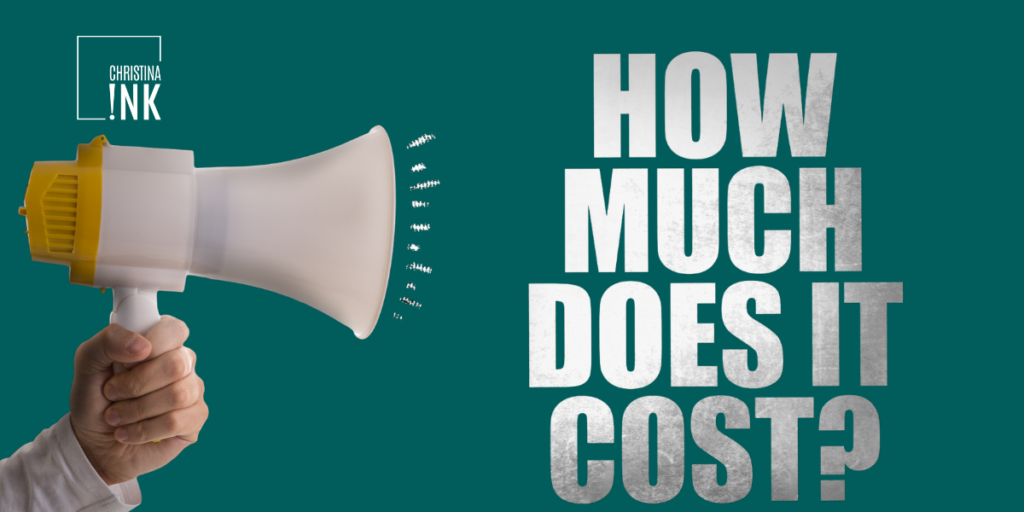
Starting a brand whether retail or online costs money. In 2024 you need access to capital to start and scale an online biz.
Establishing a brand on Amazon involves several costs. One of the first costs is opening a Professional Amazon seller account which requires a monthly fee. There are additional fees for Amazon storing and shipping your products. These fees change throughout the years and range during peak season, and are size dependant. We call these Amazon referral fees. Amazon fees range for:
- Amazon FBA
- Amazon FBM
- Seller Fees
- Misc. Fees
The referral fee represents the “commission” remitted to Amazon for every product sold through their platform. Generally, this fee is a fixed percentage, commonly 15% or lower. The referral fees are deducted from your Amazon account following the completion of a sale, which is a common reason sellers flock to the platform. Find the full details regarding Amazon seller fees here.
Following the professional selling account fee, referral fees, and trademark fees, you’ll want to ensure you have enough money for the following:
- Product Samples
- Product Packaging & Branding
- Website Development
- Social Media Marketing
- Amazon Listing Optimization / Product Images / A+ Content
- Inventory & Reordering Costs
- Legal Fees (if any)
- Amazon Product Videos
- Amazon PPC
- Influencer Marketing & UGC
- Shipping & Storage
- Amazon Fees
- Insurance
These are just some of the hidden fees associated with starting an Amazon FBA business. In 2024, you’re not simply flipping private label products from Alibaba.com, you’re building a fully functional e-commerce brand.
How Much Does it Cost to Get a Brand Approved on Amazon?
Amazon’s Brand Registry provides an extra layer of protection and marketing tools for brand owners. The costs associated with getting a brand approved on Amazon primarily revolve around obtaining a trademark for your brand.
Trademark registration costs can vary widely, depending on factors like the type of trademark, the class of goods or services, and the legal assistance you choose. It’s crucial to research and budget for these costs as part of your overall business strategy. Here are a couple names of trademark services that focus in the Amazon FBA niche:
- Trademark Angel
- Cabilly & Co.
- Rich Goldstein Law
Do I Need to Create a Brand on Amazon?
While it’s not mandatory to create a brand on Amazon, we highly recommend doing so. Amazon isn’t shy about its preferences towards recognized brands on their platform. Creating a brand will help you establish your business as a leader. A branded presence also helps distinguish your products from competitors, builds trust with customers, and opens the door to enhanced marketing and advertising opportunities.
A recognizable brand can also foster customer loyalty, encouraging repeat business. In the competitive landscape of e-commerce, creating a brand isn’t just about a logo and a name; it’s about crafting a narrative that resonates with your target audience.
How Amazon Brand Registry Can Help Establish Your Brand

Enrolling in Amazon Brand Registry is a crucial step to protect your intellectual property and enhance your brand presence on the platform. The process involves several key steps:
Eligibility Check: Ensure your brand is eligible for enrolment by holding an active registered trademark. Sellers are able to access trademarks in different countries of origin for faster processing times, but doing does not aid in the prevention of listing hijacking. To prevent hijackers sellers much be trademarked in the marketplace where the the hijacking occurs.
Create or Log in to an Amazon Account: If you don’t have an Amazon account, create one. If you already have one, log into your Seller Central account.
Navigate to Brand Registry: In Seller Central, navigate to the Brand Registry section and click on “Enroll a New Brand.”
Provide Brand Information: Enter essential information about your brand, including the registered trademark details, brand name, and product categories.
Submit Documentation: Submit supporting documentation, such as images of the product with branding visible, images of the product packaging, and a copy of the registered trademark certificate.
Wait for Approval: Amazon will review your submission, and once approved, you’ll gain access to enhanced brand protection tools and features.
Create A Compelling Amazon Listing to Solidify Your FBA Brand
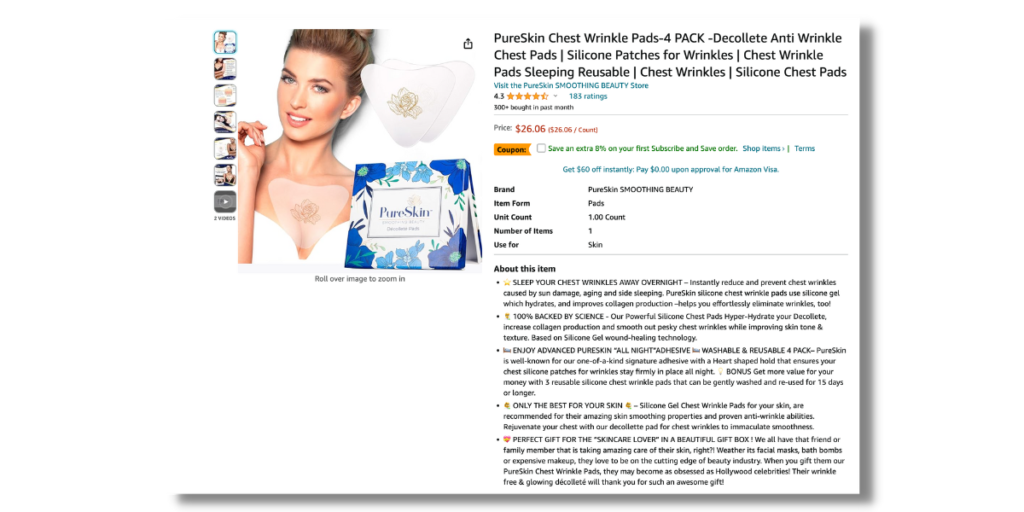
Creating an Amazon listing is essential and a required step for building a brand on the platform. This detailed product listing serves as the digital storefront for your brand, providing customers with crucial information about your products.
An Amazon listing may include several sections but not all are mandatory:
- SEO-title & Keywords
- Bullet Points
- HTML Description
- Amazon Product Images
- Amazon Brand Story
- A+ Content & Premium Content
- Amazon Storefront
- Amazon Product Video
A well-crafted Amazon listing not only attracts potential customers but also establishes trust. The listing is the foundation that showcases your products and unlocks access to a range of tools and features crucial for brand visibility and growth on the Amazon marketplace.
For a comprehensive listing tutorial, read our Ultimate Guide to Listing Optimization article.
Review the listing upload steps below:
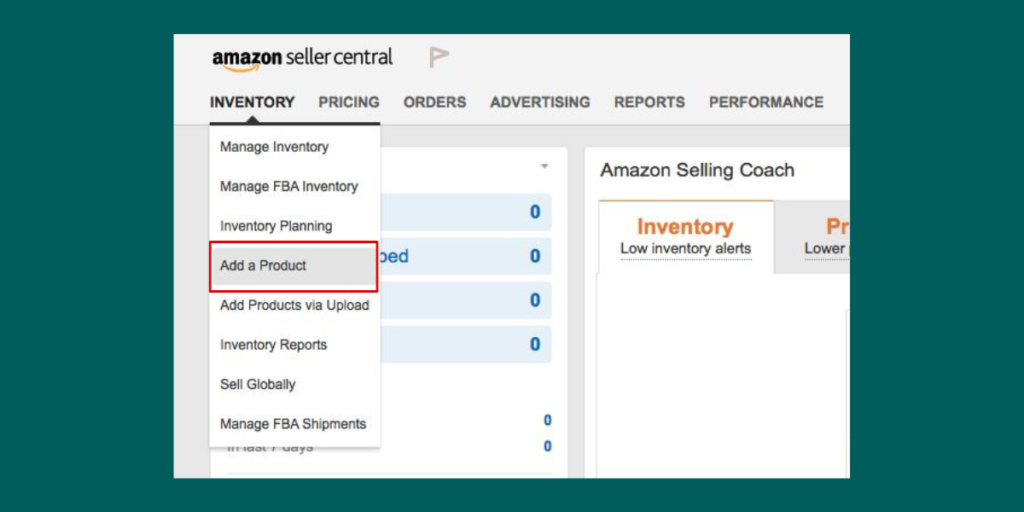
- Step 1 Access Amazon Seller Central: Log in to your Seller Central account.
- Step 2 Navigate to Inventory: Go to the “Inventory” tab and select “Add a Product.”
- Step 3 Choose a Category: Select the appropriate product category for your listing.
- Step 4 Fill in Listing Details: Provide essential details for your product, including title, key features, product description, and other relevant information.
- Step 5 Add Images: Upload high-quality Amazon images that showcase your products best features and benefits. Follow Amazon’s image guidelines for optimal results.
- Step 6 Set Pricing and Quantity: Specify your product’s price and the quantity you have available for sale.
- Step 7 Manage Inventory: Enter details such as SKU, condition, and other inventory-related information.
- Step 8 Optimize Keywords: Utilize relevant keywords in your listing to enhance discoverability. Consider using tools like DataDive Tools for keyword research.
- Step 9 Preview and Submit: Preview your listing to ensure accuracy and completeness. Once satisfied, submit your product listing.
- Step 10 Wait for Approval: Amazon will review your listing, and once approved, your product will be live on the platform. Amazon will scan the content for accuracy and to ensure your listing upholds it’s code of conduct. Its wise to review your listing meticulously for any triggering content that could see your upload denied.
- Step 11 Monitor and Update: Monitor your listing’s performance, gather customer feedback, and make necessary updates to optimize your product presence on Amazon. Record all changes you make to the listing so you can effectively monitor performance, accuracy, and customer satisfaction.
By enrolling in Amazon Brand Registry, brand owners can secure their intellectual property rights, while creating a compelling Amazon listing involves providing accurate and appealing product details for potential customers. Following these steps ensures a strong foundation for establishing and promoting a brand on the Amazon platform.
How Exactly Can I Brand My Product on Amazon?
Branding your product on Amazon involves more than just a name and logo and more than simply uploading a new product listing as we’ve already uncovered.
Perform product research to unlock a market with significant opportunity. Amazon product research will help you validate demand for your product on Amazon, but its wise to investigate off-Amazon demand as well. Next, evaluate how you can stand out from competitors with a unique brand story to help compel shoppers to act.
Your brand will be visible to a wide audience on and off of Amazon if you play your marketing cards wisely.
#1 Product Research
To initiate a successful venture on Amazon, thorough product research is paramount. This involves conducting comprehensive market research to identify high-demand niches and meticulously assessing competitors to discern unique selling points for your product.
Leveraging specialized Amazon tools such as Jungle Scout or Helium 10 becomes instrumental in this process, aiding in the analysis of Amazon keywords, tracking product trends, and evaluating potential profitability. This dual-pronged approach ensures a well-informed entry into the market, allowing you to position your product strategically for maximum visibility and success on the Amazon platform.
Here are a few quick Amazon product research tips:
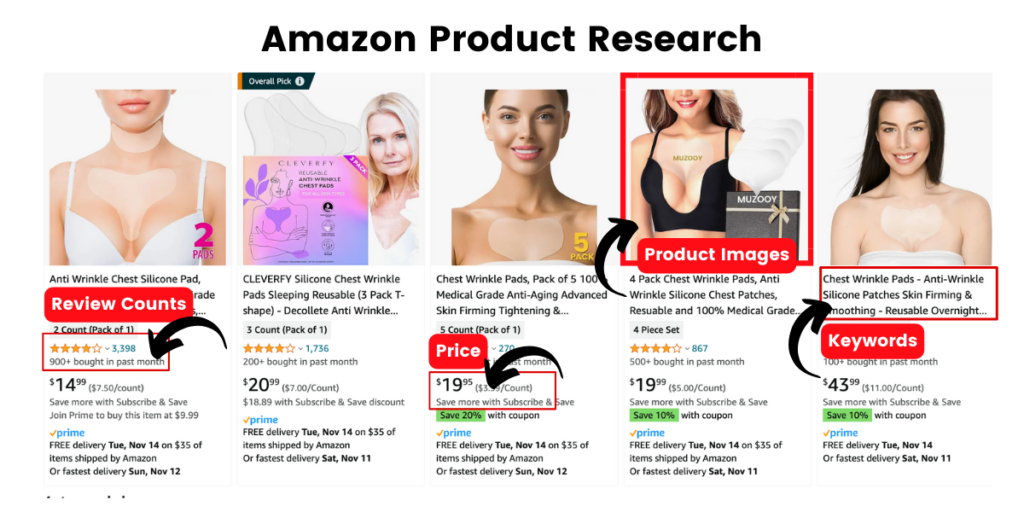
- Year-Round Demand: Select a non-seasonal product with consistent year-round demand to avoid dead inventory issues.
- Compact and Light: Ensure your product fits in a small, flat-rate box and weighs no more than two pounds.
- Brand Matters: Examine competitors Amazon listings for a low-budget branding, poor Amazon product images, and brands that aren’t brand registered signalling a low barrier to market entry and potential for product improvement.
- Avoid Electronics To Start: Choose uncomplicated products to minimize customer service challenges and sourcing complexities. Technology and electronics can be fickle so be mindful.
- Unregulated Categories: Opt for products in categories that are easy to get approval for, avoiding complications with regulations.
- Ideal Pricing: Aim for a moderate price range of $20 to $35 to attract a broad customer base. Don’t forget that range must include your total landed costs. If you don’t have the budget for a $35 product you may want to stick closer to the $10-15 range.
- Sales Velocity: Ensure a minimum of 500 monthly sales to maintain a healthy sales velocity and market presence.
- Healthy Review Competition: Look out for in-demand products that have a healthy review threshold you can compete with. That may mean avoiding products with hundreds of sellers and thousands of reviews each.
#2 Market & Demographic Research
Effective market research and target demographic analysis are pivotal steps in successfully marketing a brand on Amazon. In-depth market research involves understanding the competitive landscape, identifying trends, and pinpointing opportunities.
Analyzing competitor products and customer reviews provides valuable insights into consumer preferences and pain points, enabling you to position your brand strategically. Simultaneously, conducting target demographic and unearthing buyer psychology helps tailor your marketing efforts to the specific needs and preferences of your ideal customer.
By delving into factors like age, gender, location, interests, and emotions, you can craft targeted product listings, advertising campaigns, and promotional strategies that resonate with your audience. This approach ensures that your brand not only stands out amid the competition but also establishes a meaningful connection with the right customers, ultimately driving success on the Amazon platform.
#2 Inventory Analysis
Determining the initial inventory quantity is a critical step for Amazon sellers aiming to establish a successful FBA brand. To understand inventory levels, sellers should employ a methodical approach to analyze market demand, product velocity, and lead times.

Initial Inventory Analysis:
- Market Research: Begin by thoroughly researching your product niche and understanding its demand on the Amazon platform. Analyze competitor performance, identify seasonal trends, and consider external factors affecting demand.
- Sales Velocity: Evaluate the expected sales velocity by examining historical data for similar products on Amazon. This provides insights into how quickly products in your niche typically move off the shelves.
- Lead Times: Factor in the lead time between placing an order with your supplier and the inventory arriving at the Amazon fulfillment center. This ensures you account for the time it takes for your product to become available for sale.
- Buffer for Unforeseen Circumstances: Consider potential disruptions or unexpected increases in demand. Maintain a buffer to accommodate shipping delays, supplier issues, or unforeseen circumstances.
Calculating and Forecasting Reordering:
- Reorder Point Calculation: Determine the reorder point by calculating the quantity of inventory that, when reached, triggers the need to place a new order. This is often based on the lead time demand – the product’s average sales per day multiplied by the lead time in days. Reorder Point = (Average Daily Sales * Lead Time in Days) + Safety Stock
- Safety Stock: Safety stock acts as a buffer to guard against unexpected fluctuations in demand or supply chain disruptions. It’s an additional quantity of inventory held to mitigate risks. Safety Stock = (Maximum Daily Sales – Average Daily Sales) * Lead Time in Days
- Economic Order Quantity (EOQ): Employ the EOQ model to determine the optimal order quantity and consider factors like order and holding costs. EOQ = √((2 * Demand * Ordering Cost) / Holding Cost per Unit)
- Sales Forecasting: Utilize historical sales data and market trends to project future demand. Leverage Amazon’s forecasting tools and external software solutions for more accurate predictions.
- Reorder Frequency: Determine the optimal reorder frequency by balancing the costs associated with placing orders and holding inventory. Consider factors like storage fees, supplier terms, and shipping costs.
- Regular Review and Adjustment: Regularly review and adjust your inventory strategy based on changes in market conditions, customer behavior, and any alterations in your product or pricing strategy.
By combining a thoughtful initial inventory analysis with a robust system for calculating and forecasting reorder quantities, sellers can maintain a balanced inventory level, reduce stock outs, and optimize costs. Consistent monitoring and adjustment of these calculations ensure adaptability to the dynamic e-commerce landscape and contribute to the long-term success of an Amazon FBA brand.
#3 Product Packaging & Inserts
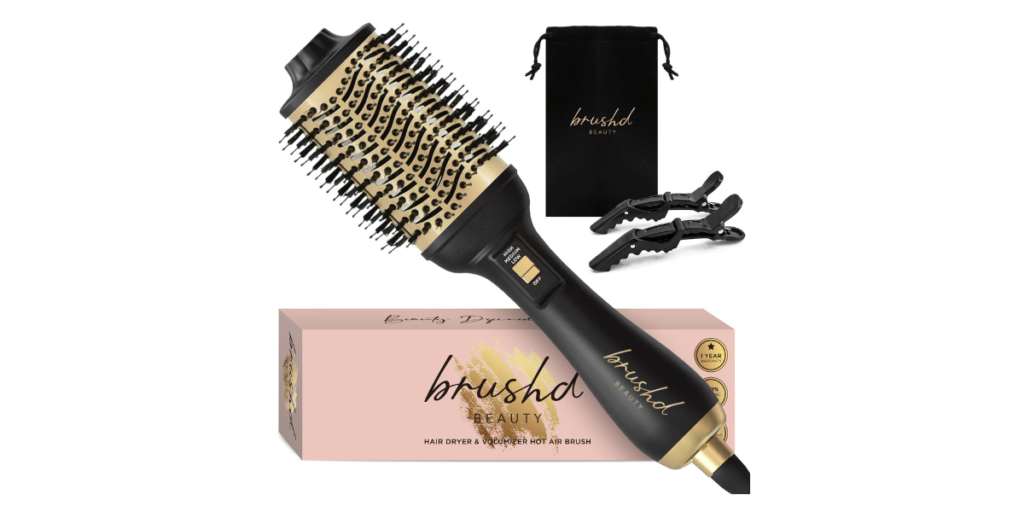
In the competitive landscape of Amazon, the visual appeal of your product matters. Design eye-catching packaging that not only stands out in Amazon’s search results but also aligns with the platform’s guidelines.
Consider eco-friendly options as more shoppers resonate with brands that go the extra mile in caring for the environment. Dare to stand out with product packaging keeping in mind that packaging costs may enhance the shopper experience yet also affect your bottom line if not careful. Complement packaging with strategic inserts featuring on brand design and copywriting to help foster brand loyalty.
What is an Amazon product insert?
A product insert is a compact card or leaflet positioned within product packaging, intended to convey a message to the customer upon opening their item. Product inserts vary from basic business cards to detailed brochures with promotions and discounts. Let’s explore the best practices for Amazon product inserts, considering diverse approaches and relevant restrictions.

What is Amazon’s insert card policy as of 2024?
As of 2024, Amazon’s insert card policy generally requires adherence to certain rules:
- Non-Promotional Information: Amazon prefers insert cards to contain non-promotional information like product instructions, care tips, or usage guidelines.
- No External Links: Insert cards typically cannot include external links to websites, email addresses, social media links, or promotional material outside of the Amazon platform.
- Prohibited Content: Any content that violates Amazon’s policies, such as incentivized reviews, third-party promotions, or inappropriate material, is strictly prohibited.
- Size and Placement: The size and placement of insert cards should not interfere with the customer experience or the product itself.
- Packaging Guidelines: Insert cards should comply with Amazon’s packaging and labeling guidelines to ensure smooth processing in fulfillment centers.
For the most accurate and current information on Amazon’s insert card policy in 2024, refer directly to Amazon Seller Central.
What is the best size of a product insert card?
Consider a standard 4 x 6 postcard as an ideal size for an Amazon product insert. Some sellers opt for business card size, but we find it a bit small. Product inserts need to be clear and concise and display your brand theme in a unique and compelling manner. While you can’t link to external websites and social media channels, customers may be compelled to Google more information about your brand if your product insert card stands out. Be mindful of oversized insert cards as they can get expensive.
Consider whether your insert card will be crafted on standard or heavy cardstock with a matte or glossy finish. Don’t forget that embossing and gold stamping can get expensive, so always check with your supplier before making final decisions. Cost is factor in what Amazon product insert you choose.
#4 Shipping & Logistics
When building your FBA (Fulfillment by Amazon) brand, you’ll need to carefully consider both air and land shipping logistics to ensure a smooth and efficient supply chain. Here are key considerations for each:
- Air Shipping: Speed vs. Cost: Air shipping is faster but generally more expensive than land shipping. Aim to strike a balance between cost-effectiveness and meeting customer expectations for quick delivery.
- Weight and Size Restrictions: Air shipping often has weight and size restrictions. Ensure your products comply with these limitations to avoid additional fees or delays.
- Shipping Methods: Different air shipping methods, such as express or standard, offer varying levels of speed and cost. Choose the method that best aligns with your business strategy and customer expectations.
- Customs and Import Regulations: Navigate customs and import regulations when using air shipping. Proper documentation and compliance with regulations are essential to prevent delays or issues.
- Lead Times: While land shipping takes longer than air, it often provides more predictable lead times.
General Considerations for Both Air and Land Shipping:
- Inventory Placement: Utilize Amazon’s FBA program strategically by considering inventory placement options.
- Shipping Partners: Establish relationships with reliable shipping partners, whether for air or land transport. Dependable partners contribute to a smooth logistics process.
- Market Demand: Consider the geographical distribution of your target market. If there’s a high concentration of customers in a specific region, optimizing land shipping for that area may be more cost-effective.
- Seasonal Variations: Understand how seasonality impacts shipping costs and delivery times. This is crucial for managing inventory and meeting demand during peak seasons.
By carefully considering these factors and choosing a shipping strategy that aligns with the nature of your products and customer expectations, you can build a robust and efficient supply chain for your FBA brand. Regularly review and adapt these strategies to ensure ongoing success in the ever-evolving e-commerce landscape.
#5 Brand Guide & Foundational Copywriting
Creating a comprehensive brand guide is essential for establishing a cohesive and recognizable brand identity no matter the sales channel. Here’s a step-by-step overview on how to create a compelling brand guide complete with a logo, hex colors, taglines, and slogans:

- Step 1 Define Your Brand Identity: Clearly articulate your brand values, mission, and vision. Understand the emotions and values you want your brand to evoke.
- Step 2 Identify Target Audience: Understand your target audience, their preferences, and the messaging that resonates with them. Tailor your brand guide to appeal to this specific demographic.
- Step 3 Develop a Unique Value Proposition: What sets your brand apart from competitors? This unique value proposition should be reflected in your logo, taglines, and slogans.
- Step 4 Create a Logo: Ensure your logo is versatile, scalable, and communicates the essence of your brand. Work with a professional graphic designer for the best results
- Step 5 Choose Your Hex Colors: Outline your primary and secondary colors, and specify hex codes for consistency. You’ll leverage your brand colors across your Amazon product images, A+ Content, Amazon Storefront, Website and social media channels, so choose wisely.
- Step 6 Determine Typography: Choose fonts that complement your brand image. Specify font families for headings, subheadings, and body text to maintain consistency in all brand communications.
- Step 7 Craft Taglines and Slogans: Develop concise and memorable taglines that encapsulate your brand messaging. Consider incorporating your unique value proposition and appealing to your target audience. Use AI models to help create several tag lines and weed out ones that don’t fit your brand persona.
- Step 8 Define Logo Usage Guidelines: Establish guidelines for how your logo should be used. Specify acceptable variations, sizes, and clear space requirements to ensure consistency across different platforms.

- Step 9 Brand Voice and Tone: Define your brand’s voice and tone. Outline the language style that should be used in different communication channels to maintain a consistent brand personality.
- Step 10 Accessibility Considerations: Ensure your brand guide includes considerations for accessibility, such as high-contrast color options and accessible font choices.
- Step 11 Put it All Together: Most graphic designers create brand guides with the purchase of a logo or brand design service. The final result is typically a PDF file that contains a visual presentation of the brand guide and its components as listed above.
By following these steps, you’ll create a comprehensive brand guide that serves as a valuable resource for maintaining consistency across all aspects of your brand.
#6 Website Development
Establishing an online presence beyond the Amazon platform is a strategic move for Amazon sellers, and creating a website is part of the overall branding process.
The first step involves choosing the most suitable platform based on personal preferences and technical comfort. You’ll hear a lot of different opinions about the best hosting sites and platforms but ultimately simplicity is okay when first starting out.
Select a unique domain name that aligns with your brand and register it through a domain registrar. Next, customize the design by selecting a template or theme that suits your brand aesthetic and business needs. WordPress, Wix and Shopify offer a variety of free and premium templates to streamline the design process.
Tailor your chosen template to match your brand identity by customizing colors, fonts, layout, and adding your logo and relevant brand details that you created in the step above. Create essential pages such as Home, About Us, Products/Services, and Contact, incorporating engaging content that introduces your brand and showcases your products.
If you’re selling products directly from your website, integrate e-commerce features using plugins or apps provided by WordPress or Wix. Implement basic search engine optimization (SEO) practices to enhance your website’s visibility on search engines.
Lastly, ensure your website is mobile-responsive to improve the user experience for visitors accessing it through mobile devices. Thoroughly test the website for functionality, responsiveness, and user experience before publishing. If you’re not comfortable with the technical aspects or prefer a professional touch, consider hiring Christina Ink or freelancers via platforms like Upwork or Fiverr. Regularly update your website with new product listings, blog articles, or any changes to your brand to keep it current and engaging for visitors.
#7 Social Media Marketing
Extend your brand’s reach beyond Amazon by using social media platforms strategically. Drive external traffic by creating a community leveraging social channels like Instagram, Facebook, Pinterest, TikTok and more. Consider running targeted ads across platforms to increase brand awareness and attract potential customers.

For details about how to leverage social media to help market your Amazon FBA business, read The Benefits of a Social Media Strategy in Your Amazon FBA Business.
#8 Customer Reviews & Feedback
Proactively managing customer reviews and feedback is crucial for building a positive brand reputation. Off Amazon, encourage customers to leave reviews through email marketing, social media, and inserts, emphasizing excellent customer service. Respond promptly and professionally to Amazon customer feedback, showcasing a commitment to customer satisfaction while following Amazon’s code of conduct. Reviews are the lifeline to any e-commerce brand, so keep them authentic and rolling in!
#9 Brand Ambassadors & Loyalty
Identifying and cultivating brand ambassadors among satisfied customers can amplify your brand’s reach. Recognize customers who provide user-generated content and implement loyalty programs outside Amazon to reward repeat customers. Satisfying Amazon’s rules on platform is key, but establishing a community off-Amazon is crucial, brand ambassadors and UGC creators can help you achieve just that.
#10 Advertising Campaigns
Amazon PPC campaigns will be a driver of your brand’s success on the platform. Take a targeted approach to increase visibility and drive traffic to your product listings.
Regularly analyze Amazon’s advertising analytics to refine your campaigns, ensuring maximum return on investment. When in doubt, enlist the help of a reputable Amazon advertising agency to help navigate Amazon PPC.
Consider an off-Amazon advertising approach with Google ads, Facebook ads, and more. Set a realistic budget and avoid advertising out of your means. Ad costs can quickly skyrocket so having a firm grip on your financials is paramount.
#11 Data Analysis & Optimization

Continuous improvement is key in the success of your Amazon FBA brand. Regularly analyze the data and analytic, Amazon provides, including sales data, conversion rates, and CTR’s. Stay informed about changes in Amazon algorithms and policies, adapting your branding strategy for ongoing optimization and success.
Optimize your product listings with high-quality images, compelling product descriptions, and relevant keywords. Use Enhanced Brand Content (EBC) or A+ Content to provide a richer shopping experience. Leverage Amazon’s advertising tools to increase visibility, and consider creating a storefront to showcase your brand’s entire product line. Consistency in branding across all touch points, from packaging to customer communications, reinforces brand identity and builds trust.
By systematically following these steps, you’ll effectively brand your product on Amazon, ensuring a compelling and cohesive presence that resonates with customers and sets your product apart in the competitive marketplace.
Conclusion
Building a successful Amazon FBA brand in 2024 requires a strategic approach with a unique edge.
From understanding Amazon selling fees, brand registry, to crafting a unique brand persona and voice, each aspect plays a crucial role in establishing a strong and reputable presence on the world’s largest e-commerce platform. By staying informed, adapting to market trends, and prioritizing customer satisfaction, entrepreneurs can navigate the evolving landscape and thrive in the competitive world of Amazon FBA.
Questions about starting an Amazon FBA brand? We’re here to help. Drop your q’s in the comments.

LIKE THIS ARTICLE?